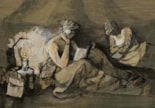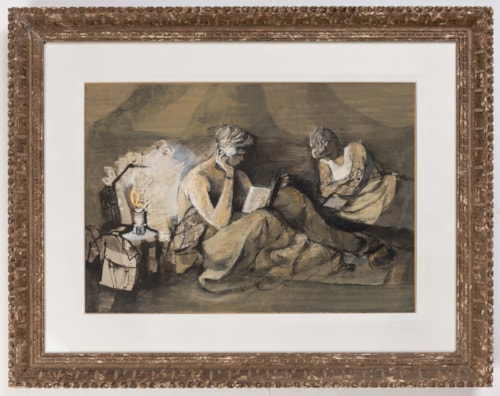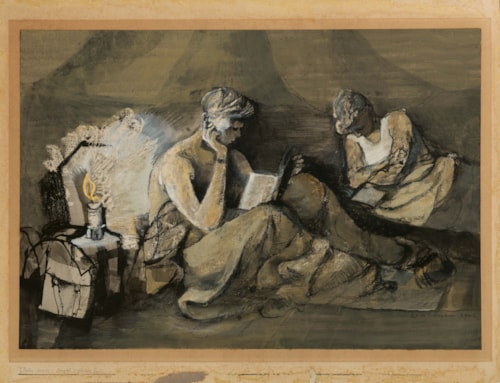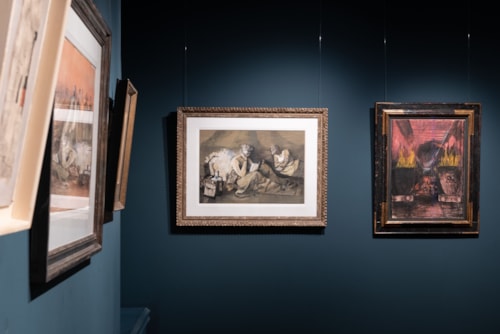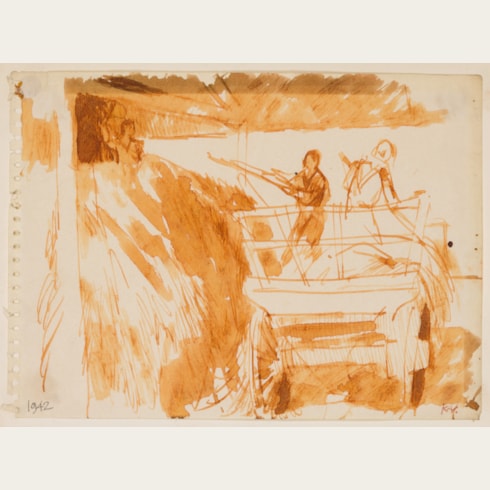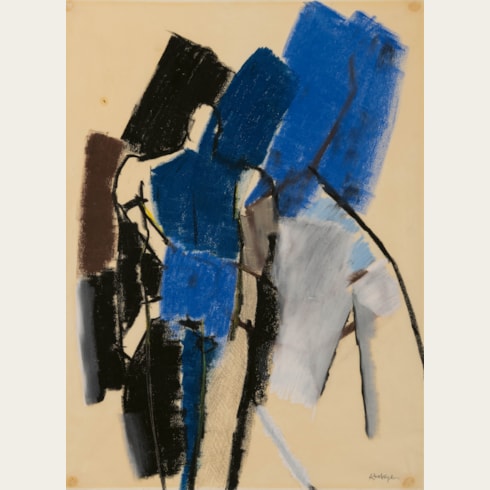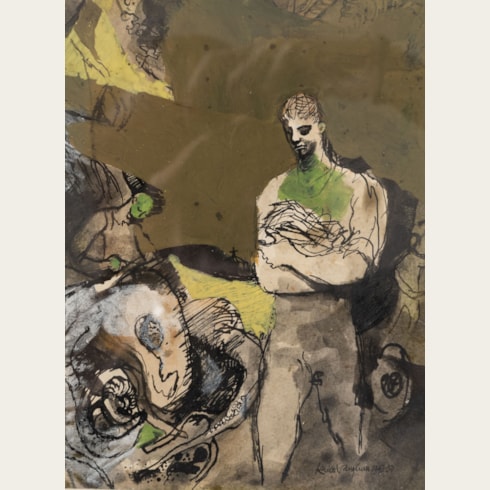Keith VAUGHAN
(Selsey 1912 - London 1977)
Under Canvas: Night Orderlies Tent
Sold
Gouache, ink and mixed media on paper laid onto board.
Signed and dated Keith Vaughan 1945 at the lower right.
Titled 'Under Canvas – Night Orderlies Tent' in the lower left margin.
373 x 540 mm. (14 3/4 x 21 1/4 in.)
Signed and dated Keith Vaughan 1945 at the lower right.
Titled 'Under Canvas – Night Orderlies Tent' in the lower left margin.
373 x 540 mm. (14 3/4 x 21 1/4 in.)
While serving in the Non-Combatant Corps during the Second World War, and since there was a limited range of media that could be carried in a regulation army knapsack, Keith Vaughan became adept at expressing himself through the graphic mediums of Indian ink, pencil, crayon and gouache; the latter usually in dark military colours of green and ochre. As he wrote in the foreword to his first gallery exhibition of drawings in 1944, in which several of his army drawings were included, ‘On New Year’s Day 1941, the first thing that went into my brand new army haversack was the largest drawing book it would accommodate and an unbreakable bottle of black ink…I now spent my off-duty hours with a pad on my knee on my bed in a barrack room. For a year I drew the raw material that was in front of me. By 1942 I had done all I wanted of this…To accommodate my slightly increased ambitions, I added to my materials one or two more bottles of ink, two pots of gouache and a few crayons. With these I hoped to be able to recover something of the solidity and depth of oil, while satisfying the requirements of intermittent work and total concealment of the result.’ The early 1940s found Vaughan executing numerous drawings of his surroundings, the barracks and fellow soldiers and labourers, some in sketchbooks and some on much larger paper and typically filled out with gouache. Dated 1945, the present sheet is an exceptional example of the latter, and can be counted among the very finest of Vaughan’s rare wartime drawings.
This fairly large, fully-signed and dated gouache composition, almost certainly intended as an autonomous work of art, is likely to have been drawn at Eden Camp, a prisoner of war detainment centre near Malton in North Yorkshire, midway between York and Scarborough, where the artist was stationed in the summer of 1943. As a biography of Vaughan notes of his time at Eden Camp, ‘At first he lived in the huts with the other men, and made a few more of the barrack-life sketches he had done [earlier], but he soon volunteered to go on almost permanent night-duty, sleeping in the office in case the telephone should ring. He wrote [to his friend Norman Towne]…‘For nearly 12 hours each day, from 7pm to 7am, I am alone and undisturbed and quiet by the fire in the Company office, where I sleep, and think.’ It was the nearest thing you could get to being in a twentieth-century monastery, he told Towne…Eden Camp was a safe haven from the war so the sufferings of Europe could be forgotten for weeks at a time.’ Vaughan remained at Eden Camp, working as a clerk and occasional German interpreter, until his demobilisation from the Pioneer Corps in March 1946.
Although Vaughan began to focus on oil painting from 1946 onwards, he continued to work in the water-based medium of gouache throughout his career, usually for highly finished, independent works. As has been noted, ‘Between 1941 and 1946 Vaughan had produced well over 400 works in gouache…which relied for their effects on the quick-drying qualities of gouache and the way it could be washed over water-resistant crayon or drawn over in ink when dry. He continued to work prolifically in this medium throughout the 1940s and 1950s.’ In 1943 the War Artists’ Advisory Committee purchased twelve of Vaughan’s wartime gouaches, a number of which were included in an exhibition of war art organized by Kenneth Clark at the National Gallery. By the 1950s Vaughan’s gouaches were being exhibited at galleries in London and New York, and were much in demand among collectors.
This fairly large, fully-signed and dated gouache composition, almost certainly intended as an autonomous work of art, is likely to have been drawn at Eden Camp, a prisoner of war detainment centre near Malton in North Yorkshire, midway between York and Scarborough, where the artist was stationed in the summer of 1943. As a biography of Vaughan notes of his time at Eden Camp, ‘At first he lived in the huts with the other men, and made a few more of the barrack-life sketches he had done [earlier], but he soon volunteered to go on almost permanent night-duty, sleeping in the office in case the telephone should ring. He wrote [to his friend Norman Towne]…‘For nearly 12 hours each day, from 7pm to 7am, I am alone and undisturbed and quiet by the fire in the Company office, where I sleep, and think.’ It was the nearest thing you could get to being in a twentieth-century monastery, he told Towne…Eden Camp was a safe haven from the war so the sufferings of Europe could be forgotten for weeks at a time.’ Vaughan remained at Eden Camp, working as a clerk and occasional German interpreter, until his demobilisation from the Pioneer Corps in March 1946.
Although Vaughan began to focus on oil painting from 1946 onwards, he continued to work in the water-based medium of gouache throughout his career, usually for highly finished, independent works. As has been noted, ‘Between 1941 and 1946 Vaughan had produced well over 400 works in gouache…which relied for their effects on the quick-drying qualities of gouache and the way it could be washed over water-resistant crayon or drawn over in ink when dry. He continued to work prolifically in this medium throughout the 1940s and 1950s.’ In 1943 the War Artists’ Advisory Committee purchased twelve of Vaughan’s wartime gouaches, a number of which were included in an exhibition of war art organized by Kenneth Clark at the National Gallery. By the 1950s Vaughan’s gouaches were being exhibited at galleries in London and New York, and were much in demand among collectors.
Born in Sussex, Keith Vaughan moved with his family to North London around the start of the First World War. He showed a gift for the arts from a very young age, earning a Royal Drawing Society certificate at the age of seven, but received almost no formal artistic education and was mostly self-taught. While at boarding school, Vaughan was given special entitlements to study art, since he was the first student to specialize in it, and it was at the Christ’s Hospital school that he mounted his first exhibition of landscapes. At the age of nineteen, Vaughan began work as a trainee in the art department of an advertising firm, where he remained until just before the start of the Second World War. In 1939 he left the firm and moved to the country, intending to paint for a year; this would be the first consistent time Vaughan would spend as a fine artist since his school days. It was also at around this time that he began keeping a written journal, a practice he maintained until his death, and which eventually amounted to some 750,000 words contained in sixty-one volumes.
During the Second World War, Vaughan declared himself a conscientious objector, and was conscripted into the Non-Combatant Corps (NCC), working as a labourer in Wiltshire and Derbyshire. It was during the war that, through the collector Peter Watson, Vaughan came into contact with such contemporaries such as Graham Sutherland and John Minton, both of whom were to be highly influential on the artist’s developing career, as well as John Craxton. It was also during this time that Vaughan began exhibiting his work, first in a group exhibition of War Artists organized by Kenneth Clark at the National Gallery in London in 1943, followed by a small show of drawings – of army subjects, landscapes and figures – at the Alex Reid & Lefevre Gallery in London at the end of the following year.
After the war Vaughan began to work consistently in oil paint. Leaving the army in 1946, he taught part-time at the Camberwell School of Art and held the first exhibition of his paintings and gouaches at the Lefevre Gallery. The same year he moved into a house and studio in Maida Vale that he shared with Minton, working alongside him for the next six years. Vaughan’s postwar style was very different from that of the 1930s, with the artist focussing on oil painting and more fully finished compositions and turning away from the English Neo-Romanticism of his earlier work. He also produced designs for book jackets, magazine illustrations and advertisements, and received an important commission for a fifty-foot-long mural for the Dome of Discovery, a temporary building erected on the South Bank for the 1951 Festival of Britain, which is now lost. Focussing on the nude male form, Vaughan’s work also became more abstract; in 1952 he saw an exhibition of the work of Nicolas De Staël and came away impressed with the French artist’s abstractions. Although today regarded as perhaps the pre-eminent painter of the male nude of the postwar period, Vaughan’s concurrent interest in landscape painting, inspired by his travels around Britain, Ireland, France, Italy, Greece, Spain and Morocco, is such that almost half of his extant paintings are landscapes.
By the first half of the 1950s Vaughan was exhibiting regularly at the Lefevre, Redfern and Leicester Galleries in London, and also at Durlacher gallery in New York. In his later years he taught at the Central School of Art and the Slade School of Art, as well as at Iowa State University in America. The peak of Vaughan’s success came in the 1950s and early 1960s, culminating in a major retrospective exhibition of his work, numbering over three hundred paintings, gouaches and drawings, at the Whitechapel Art Gallery in London in 1962. The exhibition was a critical success, one reviewer commenting that ‘One remains in no doubt, within five minutes of entering the retrospective exhibition of paintings and drawings by Keith Vaughan, that one is in the presence of a very considerable artist and a very consistent one.’ Not long after this, however, the artist began to fear that his works were being overshadowed by newer movements in art, notably British Pop Art and Abstract Expressionism, though he continued to have regular exhibitions in galleries in Britain and America, notably at the Waddington Galleries in London. His health began to worsen and he underwent a series of major operations that sapped him of his energy and exacerbated a tendency to depression. On the morning of 4 November 1977, suffering from terminal cancer, Vaughan committed suicide with a fatal overdose of pills, writing in his journal to the very end.
During the Second World War, Vaughan declared himself a conscientious objector, and was conscripted into the Non-Combatant Corps (NCC), working as a labourer in Wiltshire and Derbyshire. It was during the war that, through the collector Peter Watson, Vaughan came into contact with such contemporaries such as Graham Sutherland and John Minton, both of whom were to be highly influential on the artist’s developing career, as well as John Craxton. It was also during this time that Vaughan began exhibiting his work, first in a group exhibition of War Artists organized by Kenneth Clark at the National Gallery in London in 1943, followed by a small show of drawings – of army subjects, landscapes and figures – at the Alex Reid & Lefevre Gallery in London at the end of the following year.
After the war Vaughan began to work consistently in oil paint. Leaving the army in 1946, he taught part-time at the Camberwell School of Art and held the first exhibition of his paintings and gouaches at the Lefevre Gallery. The same year he moved into a house and studio in Maida Vale that he shared with Minton, working alongside him for the next six years. Vaughan’s postwar style was very different from that of the 1930s, with the artist focussing on oil painting and more fully finished compositions and turning away from the English Neo-Romanticism of his earlier work. He also produced designs for book jackets, magazine illustrations and advertisements, and received an important commission for a fifty-foot-long mural for the Dome of Discovery, a temporary building erected on the South Bank for the 1951 Festival of Britain, which is now lost. Focussing on the nude male form, Vaughan’s work also became more abstract; in 1952 he saw an exhibition of the work of Nicolas De Staël and came away impressed with the French artist’s abstractions. Although today regarded as perhaps the pre-eminent painter of the male nude of the postwar period, Vaughan’s concurrent interest in landscape painting, inspired by his travels around Britain, Ireland, France, Italy, Greece, Spain and Morocco, is such that almost half of his extant paintings are landscapes.
By the first half of the 1950s Vaughan was exhibiting regularly at the Lefevre, Redfern and Leicester Galleries in London, and also at Durlacher gallery in New York. In his later years he taught at the Central School of Art and the Slade School of Art, as well as at Iowa State University in America. The peak of Vaughan’s success came in the 1950s and early 1960s, culminating in a major retrospective exhibition of his work, numbering over three hundred paintings, gouaches and drawings, at the Whitechapel Art Gallery in London in 1962. The exhibition was a critical success, one reviewer commenting that ‘One remains in no doubt, within five minutes of entering the retrospective exhibition of paintings and drawings by Keith Vaughan, that one is in the presence of a very considerable artist and a very consistent one.’ Not long after this, however, the artist began to fear that his works were being overshadowed by newer movements in art, notably British Pop Art and Abstract Expressionism, though he continued to have regular exhibitions in galleries in Britain and America, notably at the Waddington Galleries in London. His health began to worsen and he underwent a series of major operations that sapped him of his energy and exacerbated a tendency to depression. On the morning of 4 November 1977, suffering from terminal cancer, Vaughan committed suicide with a fatal overdose of pills, writing in his journal to the very end.
Provenance
Acquired from the artist by a private collector in the 1950s
Thence by descent to a private collection, Virginia.
Thence by descent to a private collection, Virginia.


